
The Wii is a home video game console developed and marketed by Nintendo. It was released on November 19, 2006 in North America, and in December 2006 for most other regions of the world. It is Nintendo's fifth major home game console, following the GameCube and is a seventh-generation console alongside Microsoft's Xbox 360 and Sony's PlayStation 3.
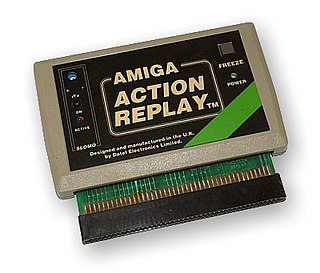
Action Replay is the brand name of a cheating device created by Datel. The Action Replay is available for many gaming systems including the Nintendo DS, Nintendo DSi, Nintendo 3DS, PlayStation Portable, PlayStation 2, GameCube, Game Boy Advance, and the Xbox. The name is derived from the first devices’ signature ability to pause the execution of the software and save the computer's state to disk or tape for future “replay”. The ability to manipulate the contents of memory in this paused state permitted the cheat functions for which the brand is now better known.
A softmod is a method of using software to modify the intended behavior of hardware, such as video cards, sound cards, or game consoles in a way that can overcome restrictions of the firmware, or install custom firmware.
Homebrew, when applied to video games, refers to software produced by hobbyists for proprietary video game consoles which are not intended to be user-programmable. The official documentation is often only available to licensed developers, and these systems may use storage formats that make distribution difficult, such as ROM cartridges or encrypted CD-ROMs. Many consoles have hardware restrictions to prevent unauthorized development.
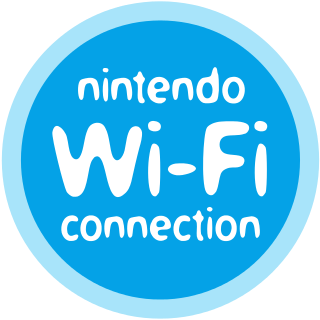
Nintendo Wi-Fi Connection is a defunct online multiplayer gaming service run by Nintendo that formerly provided free online play in compatible Nintendo DS and Wii games. The service included the company's Wii Shop Channel and DSi Shop game download services. It also ran features for the Wii and Nintendo DS systems.
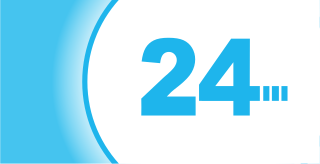
WiiConnect24 is a discontinued feature of Nintendo Wi-Fi Connection for the Wii. It was first announced at Electronic Entertainment Expo (E3) in mid-2006 by Nintendo. It enabled the user to remain connected to the Internet while the console was on standby. For example, in Animal Crossing: City Folk, a friend could send messages to another player without the recipient being present in the game at the same time as the sender.
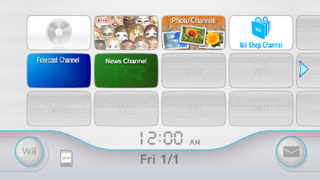
The Wii Menu is the graphical shell of the Wii and Wii U game console, as part of the Wii system software. It has four pages, each with a 4:3 grid, and each displaying the current time and date. Available applications, known as "channels", are displayed and can be navigated using the pointer capability of the Wii Remote. The grid is customizable; users can move channels among the menu's 48 customizable slots. By pressing the plus and minus buttons on the Wii Remote users can scroll across accessing empty slots.
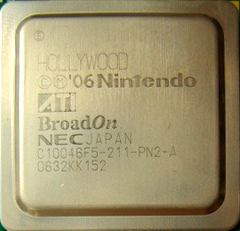
The Hollywood graphics chip is the graphics processing unit (GPU) used in Nintendo's Wii video game console. It was designed by ATI, and was manufactured using the same 90 nm or 65 nm CMOS process as Broadway, the Wii's central processing unit. Very few official details about Hollywood were released to the public by Nintendo, ATI, or any other company involved in the Wii's development. The Hollywood GPU is reportedly based on the GameCube's Flipper GPU and is clocked 50% higher at 243 MHz, though these clock rates have never been officially confirmed.

The Wii Shop Channel is a discontinued digital distribution service for the Wii video game console. The service allowed users to purchase and play additional software for the Wii, including exclusive games, and games from prior generations of video games. The Wii Shop Channel launched on November 19, 2006, and ceased operations on January 30, 2019.

The Everybody Votes Channel was a Wii Menu channel that allowed users to vote in simple opinion polls and compare and contrast opinions with those of friends, family and voters around the globe.

A Mii is a customizable avatar used on several Nintendo video game consoles and mobile apps. The name Mii is a portmanteau of "Wii" and "me", referring to them typically being avatars of the players. Miis were first introduced on the Wii console in 2006 and later appeared on the DS, 3DS, the Wii U, the Switch, and various apps for smart devices such as Miitomo. Miis can be created using different body, facial and clothing features, and can then be used as characters within games on the consoles, either as an avatar of a specific player or in some games portrayed as characters with their own personalities. Miis can be shared and transferred between consoles, either manually or automatically with other users over the internet and local wireless communications.
The PlayStation Portable system software is the official firmware for the PlayStation Portable (PSP). It uses the XrossMediaBar (XMB) as its user interface, similar to the PlayStation 3 console.

The Mii Contest Channel, known as the Check Mii Out Channel outside of Europe, Oceania and Japan, was a channel for the Nintendo Wii that allowed players to share their digital avatars, called Miis, and enter them into popularity contests.

Wii Freeloader is a bootdisc developed by Datel to circumvent regional lockout on the Wii video game console. It allows the playing of games from other regions, but does not allow the use of DVD±R, commonly used for backups, copies or homebrew. It can be used in combination with a modchip to allow compatibility with more games or to use an update blocker. The user enters the bootdisc into the Wii system, launches the application from the Wii Menu, then replaces the disc with a region-locked game disc. This disc allows the user to play foreign GameCube games, but there have been some issues reported with different signals and the games simply not working on a foreign system, even with use of the Wii Freeloader.

The Nintendo DSi system software is a discontinued set of updatable firmware versions, and a software frontend on the Nintendo DSi video game console. Updates, which are downloaded via the system's Internet connection, allow Nintendo to add and remove features and software. All updates also include all changes from previous updates.
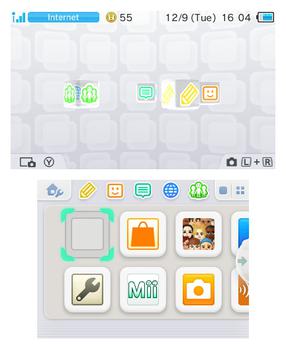
The Nintendo 3DS system software is a updatable operating system used for the Nintendo 3DS handheld system. The Nintendo Switch system software is believed to have evolved from the Nintendo 3DS operating system.
The Nintendo Network is a defunct online service formerly ran by Nintendo that provided free online functionality for the Nintendo 3DS and Wii U systems and their compatible games. Announced on January 26, 2012, at an investors' conference, it was Nintendo's second online service after Nintendo Wi-Fi Connection. Former president of Nintendo Satoru Iwata said, "Unlike Nintendo Wi-Fi Connection, which has been focused upon specific functionalities and concepts, we are aiming to establish a platform where various services available through the network for our consumers shall be connected via Nintendo Network service so that the company can make comprehensive proposals to consumers."

The Wii U operating system is the official firmware version and system software for the Nintendo's Wii U home video game console. Nintendo maintains the Wii U's systemwide features and applications by offering system software updates via the Internet. Updates are optional to each console owner, but may be required in order to retain interoperability with Nintendo's online services. Each update is cumulative, including all changes from previous updates.
SpotPass and StreetPass are communication systems first introduced in the Nintendo 3DS; SpotPass was later incorporated into the Wii U game console. SpotPass delivers content from the Internet to the consoles, and StreetPass uses local Wi-Fi functionality to exchange data between 3DS systems.

The Nintendo Switch system software is an updatable firmware and operating system used by the Nintendo Switch video game console. It is based on a proprietary microkernel. The UI includes a HOME screen, consisting of the top bar, the screenshot viewer ("Album") Icons, and shortcuts to the Nintendo eShop, News, and Settings.












